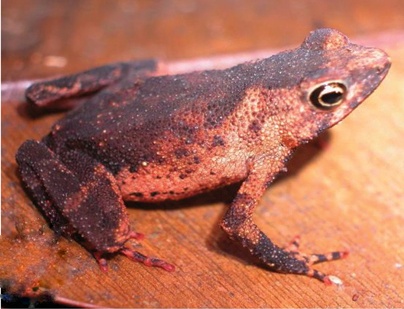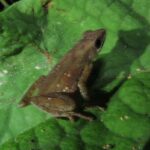- Amazophrynella vote: Exploring the Hidden World of a Little-Known Amazonian Jewel
- Taxonomy and Classification
- Natural Habitat: A Secret Realm Underfoot
- Physical Characteristics: Beauty in Miniature
- Behavior and Life Cycle: Quiet Yet Extraordinary Lives
- Ecological Role: Guardians of the Leaf Litter
- Threats and Conservation Status: Challenges of a Fragile Existence
- Cultural and Scientific Significance: Revealing Nature's Hidden Layers
- Conclusion: Preserving Delicate Links in the Web of Life
Amazophrynella vote: Exploring the Hidden World of a Little-Known Amazonian Jewel#
In the lush tapestry of biodiversity that carpets the Amazon rainforest, there’s a tiny amphibian that could easily go unnoticed, serenely hidden beneath damp leaf litter or nestled within the dense mossy flooring. Diminutive yet captivating, Amazophrynella vote represents an extraordinary piece of the ecological puzzle—a testament to the intricate complexity woven throughout South America’s richest habitats.
Despite its minimal size (barely reaching the length of an adult human thumb), Amazophrynella vote plays a critical role within its delicate ecosystem. Unlike the colorful poison dart frogs or the melodious tree frogs often spotlighted in wildlife documentaries, this humble toad garners few headlines yet embodies the intricate adaptability of amphibian species thriving in the Amazon basin. Let’s journey deep into its secretive world, uncovering stories of adaptation, survival, and the critical importance of its conservation.
Taxonomy and Classification#
Amazophrynella vote belongs to the diverse amphibian family Bufonidae, commonly known as “true toads.” Relatively mysterious and recently discovered, the species fits within the specialized genus Amazophrynella, representative of the smaller toad varieties inhabiting moist Amazonian forests. Its genus comprises several unique species recently distinguished from closely related groups, showcasing subtle yet critical evolutionary divergences.
First described formally by Catenazzi and colleagues in 2018, Amazophrynella vote exemplifies how ongoing research continues to unveil hidden biodiversity patterns. Genetic analyses suggest this tiny organism boasts noteworthy genetic distinctiveness from neighboring species, attesting to its specialized ecological niche and likely long-standing isolation through evolutionary pressures.
Natural Habitat: A Secret Realm Underfoot#
Amazophrynella vote resides deep within Peru’s Madre de Dios region—a habitat characterized by humid, pristine forests, extensive biodiversity, and abundant rainfall. These areas, blanketed with dense canopies, harbor countless plants, fungi, insects, and other amphibians. Within this intricate web of life dwell Amazophrynella frogs, occupying a microhabitat easily overlooked.
Hidden Among the Leaf Litter#
The humid leaf litter carpeting the forest floor provides Amazophrynella vote both protection and sustenance. Rotting leaves, fallen branches, fungi carpets, and moss-covered logs compose their miniature landscapes. Offering optimal humidity crucial for skin-respiration and subtle camouflage protecting against predatory eyes, these shelters foster thriving insect communities—an essential food source for the diminutive toad.
Rainfall and Moisture: The Lifeline of Amazophrynella Vote#
This species depends on constant humidity—any abrupt changes in moisture levels directly threaten its delicate existence. Seasonal rainfall shifts define its active periods; drier spells see reduced activity levels and force the toads deeper beneath their shelter, while rains lure populations upward into more accessible layers of leaf litter. Amazophrynella vote’s reliance on such precise conditions makes it an invaluable indicator species for ecosystem health, signaling subtle environmental fluctuations.
Physical Characteristics: Beauty in Miniature#
Measuring just about 20 millimeters as adults, Amazophrynella vote’s diminutive size grants remarkable concealment advantages. Unlike stereotypical perceptions of toads as bulbous, bumpy creatures, this species remarkably strikes a delicate, understated appearance, finely adapting to its niche.
A Palette of Subtle Camouflage#
The species typically exhibits brown, reddish-brown, or earthy shades with variable mottling and subtle patterning, providing camouflage perfectly matched to its surrounding environment. This color adaptation grants it stealth capabilities, blending almost effortlessly into leaf litter shadows or tree bark textures, shielding it from predators scanning forest floors.
Built for Moisture: Skin and Adaptations#
Its skin, characteristic of true toads, features subtle granular textures optimal for moisture retention and defense around delicate environments. Tiny glands release slight toxin secretions, deterring certain predators in moments of stress or danger, though these toxins are far less potent compared to its vibrant, poison-dart counterparts. Such adaptations equip Amazophrynella vote for survival in an uncertain, predation-heavy forest floor setting.
Behavior and Life Cycle: Quiet Yet Extraordinary Lives#
The behavioral patterns of Amazophrynella vote mirror, to some degree, those of other diminutive rainforest toads. Yet nuanced adaptations to their specific niche provide intriguing glimpses into evolutionary creativity.
Nocturnal Hunters of the Microcosmos#
As darkness envelops the Amazon Rainforest’s undergrowth, Amazophrynella vote stirs into its active predator phase. With alert senses finely attuned to vibrations, scents, and movement, it engages in nimble ambush tactics against a vast array of tiny forest floor invertebrates, including small ants, termites, mites, and springtails.
Courtship and Mating: Breeding Amid the Rains#
When seasonal rains saturate forest floors, the toads enter prime breeding periods. Males produce rhythmic but subtle vocalizations at night, far softer and more discreet than calls heard from larger frogs. Mating pairs subsequently seek suitable environments, depositing small clusters of eggs on shallow pools or moist openings in leaf litter, carefully chosen to maintain ideal moisture and temperature.
After several days, delicate tadpoles emerge, embarking immediately on their own distinct journeys. These larvae are specially adapted for life in shallow ephemeral habitats; they thrive amid particle detritus, algae, and microorganisms flourishing within water-saturated leaf litter pockets, steadily metamorphosing into their tiny terrestrial forms.
Ecological Role: Guardians of the Leaf Litter#
Amazophrynella vote occupies vital ecological niches, contributing both as a formidable predator of small insects and providing occasional sustenance for larger predators. Birds, snakes, small mammals, and large spiders occasionally pursue it, creating interconnected relationships central to Amazonian biodiversity.
Indicator Species: Reading the Environment through Amphibians#
As a highly sensitive amphibian dependent on precise environmental conditions, Amazophrynella vote offers a helpful “canary in the coal mine” indication of any subtle environmental disruptions. Researchers regularly monitor populations and behaviors closely, relying on such amphibians’ indicators to detect looming ecological pressures long before visible signs emerge among plants or larger animals.
Threats and Conservation Status: Challenges of a Fragile Existence#
Due to limited range, specialized ecological preferences, and small populations, Amazophrynella vote may face daunting conservation threats. Habitat destruction linked primarily to expanding agriculture, logging, and illegal mining within its limited range poses growing concerns, intensifying the importance of conservation interventions.
IUCN Status and Conservation Efforts#
Amazophrynella vote, relatively new to scientific recognition, currently awaits formal IUCN categorization. Ongoing studies and assessments, however, highlight risks to populations. Conservation professionals emphasize habitat protection initiatives and environmental impact reductions through targeted measures and community collaborations.
Cultural and Scientific Significance: Revealing Nature’s Hidden Layers#
Although not yet prominently featured in ancient mythologies or traditional human cultures, Amazophrynella vote undoubtedly contains untapped values within scientific realms. Continued in-depth investigations into their biology contribute substantially to understanding biodiversity, ecosystem dynamics, amphibian evolution, and climate change monitoring.
As bioindicators, its populations’ health and persistence speak volumes about larger ecological processes, indirectly shaping environmental awareness within relevant local and global communities.
Conclusion: Preserving Delicate Links in the Web of Life#
Amazophrynella vote embodies remarkable examples of Amazonian biodiversity’s subtle complexity and fragility. While easily overlooked amid charismatic megafauna or vibrant, colorful frogs, this toad’s covertly brilliant adaptations, micro-ecosystem reliance, and evolutionarily perfected survival strategies underscore a powerful ecological narrative.
Understanding, appreciating, and protecting Amazophrynella vote demand collaborative conservation efforts and ongoing scientific exploration to ensure their habitat’s preservation. Each step towards protecting this overlooked species reminds us of our shared responsibility—preserving unseen species ensures the overall web of life flourishes.
We encourage nature enthusiasts, advocates, students, and conservationists alike to delve deeper into the fascinating world of rainforest amphibians, lending your voice and efforts to continued Amazonian biodiversity protection. By safeguarding Amazophrynella vote and countless other hidden jewels, we secure a healthier, interconnected future for our extraordinary planet.









